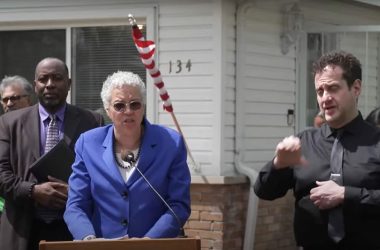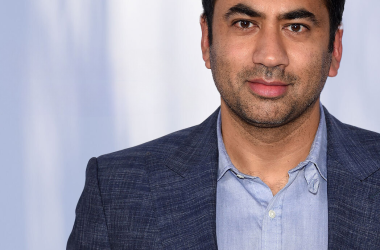
Gary Goings powerwashes the huge sculpture before treating rust and finally painting it. (PHOTO SUPPLIED)
University Park, IL-(ENEWSPF)- “Signal yellow” is the color but you wouldn’t have known that earlier this spring, after the wear and tear of 38 years of exposure to the elements had faded the monumental “Illinois Landscape No. 5” into a mellow buttercream.
John Henry’s masterwork has graced the prairie landscape at Nathan Manilow Sculpture Park (NMSP) at Governors State University since it was commissioned with the assistance of the National Endowment for the Arts in 1975.
Thousands of students and visitors have regarded John Henry’s striking work of contemporary sculpture with awe and good humor. Now, with the generous support of donors, onlookers can once again appreciate it in its full glory. Just as “signal yellow” implies, the sprawling site-specific sculpture compels visitors and passers-by to slow their pace, just to gain a glimpse.
Funding for conservation work and painting came from Pathfinder memberships and other funds collected over the past six years. “This is another important piece of the revitalization of Nathan Manilow Sculpture Park, and we have our many supporters to thank,” said Geoffrey Bates, NMSP Director and Curator.
“Illinois Landscape No. 5” is a major work of art from a variety of standpoints. “With a span of 134 feet and elements stretching vertically to nearly 50 feet the piece dominates the north side of the GSU campus,” Bates said. “But that’s not why it’s important.”
In the late 1960s John Henry helped organize Construct, a quasi-cooperative group of sculptors who almost single-handedly launched public art in the Midwest. The Chicago exhibition “Eight American Sculptors,” presented in 1968 just off Michigan Avenue in a commandeered Pioneer Court, served notice that sculpture in the U.S. was no “handmaiden of architecture.”
During an interview with the artist in April, 2012, Henry provided insight into the character of the piece. “Most of my pieces, large pieces, in those days were horizontal,” Henry recalled. “I wasn’t really building vertical pieces. And some of them were really, really low to the ground and almost…well, it was very difficult for people to grasp them as sculpture, you know, ‘cause these things would just crawl along the surface of the ground.”
“Arris,” another of John Henry’s works from this period, can be seen near McCormick Place, at the corner of Cermak Road and Indiana Avenue, just south of downtown Chicago.
The commission for “Illinois Landscape No. 5” grew directly out of Henry’s involvement with Construct and its cadre of artists who would also go on to major careers: Mark diSuvero, Richard Hunt, John Chamberlain, Charles Ginnever, Kenneth Snelson and others.
John Henry’s work has become an icon for Governors State University, an immediately recognizable symbol of the dynamic relationship between the campus and its community. The artist’s career blossomed after the installation of the piece. He has exhibited work across the world and is represented in numerous public and private collections in North and South America, Europe, and Asia. He currently lives and works in Chattanooga, Tennessee.
This preservation is one of many efforts to conserve and renew the collection at Nathan Manilow Sculpture Park, including other sculpture conservation projects, prairie restoration initiatives and efforts to transform the park into even more of a beacon of serenity. Part of GSU’s “Living With Art” initiative, Nathan Manilow Sculpture Park hosts activities and events throughout the year.
Nathan Manilow Sculpture Park is located at Governors State University at 1 University Parkway, University Park, IL 60484-0975. Celebrating its 35th Anniversary, the park has grown into a major collection of 28 works that sit within the wild prairie swales of the Governors State University campus.
Located just 34 miles directly south of Chicago’s Loop business district and connected by a one-hour Metra train ride to the Millennium Park station, the park is easily accessible by train, automobile, or tour bus, and is open free of charge 365 days a year, from dawn until dusk. Events and programs that build an appreciation and understanding of contemporary sculpture and highlight the surrounding landscape are scheduled throughout the year.
Tours of the park can be arranged for a nominal fee and offer the opportunity for groups to encounter the work in a relaxed atmosphere.
Community members who wish to support the park’s efforts to preserve the collection may do so by visiting www.govst.edu/sculpture/donate, or calling (708) 534-4486.








